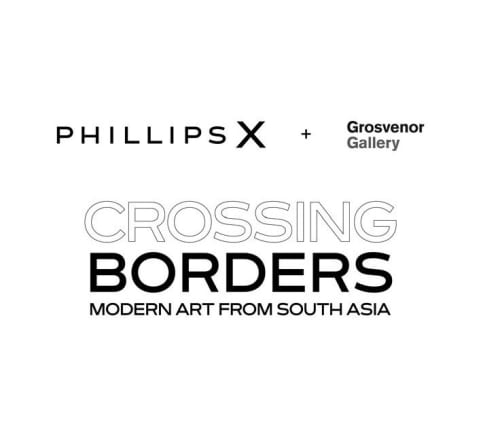PhillipsX, in collaboration with Grosvenor Gallery, Europe’s leading gallery for South Asian art, announces Crossing Borders: Modern Art from South Asia. Coinciding with an unprecedented institutional focus on South Asian art across London this year, from the Barbican to the Royal Academy, Serpentine Galleries, and Frieze Cork Street, Crossing Borders offers collectors and audiences a rare opportunity to experience and acquire significant works by artists who shaped Modernism across India, Pakistan, Bangladesh, Sri Lanka, and Nepal. This landmark selling exhibition will be on view to the public from 9 to 31 July at Phillips Berkeley Square, London.
Crossing Borders explores how artists responded to the seismic shifts of independence, partition, and post-colonial realignment by developing new visual languages – rejecting colonial paradigms and embracing contemporary materials, ideologies, and forms. Highlighted artists include F.N. Souza, S.H. Raza, M.F. Husain, Bhupen Khakhar, Ram Kumar, Rasheed Araeen, A.R. Chughtai, Syed Sadequain, George Keyt, Lain Singh Bangdel, Balraj Khanna, Mohan Samant, Ismail Gulgee, and Velu Viswanadhan.
Yassaman Ali, Director of Middle East & South Asia Regions at Phillips, said, “The current celebration of South Asian art marks a significant cultural moment – one that Phillips is proud to celebrate and participate in. Crossing Borders honours a region whose artistic voices are finally receiving the global recognition they deserve, both institutionally and commercially. We are proud to partner with Grosvenor Gallery to present this captivating body of work. We wish for the exhibition to serve as a platform to engage and inspire a diverse group of international collectors, to explore and champion the artists pioneering the narrative of South Asian Modernism.”
Conor Macklin and Charles Moore, Grosvenor Gallery, said, “We are very happy to be partnering with Phillips on what’s shaping up to be a fantastic exhibition — the scale of the show has allowed us to be especially ambitious with our selection. We have worked hard to bring in fresh works by artists from across the region, and we hope the visual dialogue between the pieces will encourage viewers to engage with artists they may not have considered before. We’re also fortunate that the exhibition coincides with a number of remarkable institutional shows of South Asian material, and we hope ours adds meaningfully to this moment.”
A major highlight of Crossing Borders is Sans titre, painted in 2001 by Paris-based Indian artist Viswanadhan, whose practice bridges Indian spiritual traditions and Western abstraction. His recent solo presentation at Sharjah Biennial 16: to carry, featured over 40 works spanning five decades. Viswanadhan’s visual language is rooted in the sacred geometry of yantras and mandalas, offering a contemplative counterpoint to the political and material explorations of his peers.
Formed in Bombay in 1947, the Progressive Artists’ Group catalysed a radical new direction for Indian art. Among its founders, Francis Newton Souza emerged as a singular force. His bold explorations of identity, religion, and colonial legacies earned him early international acclaim, including participation in the 1955 and 2024 Venice Biennales. With works held by Tate Britain and NGMA New Delhi, and record-breaking auction results in 2024–25, Souza’s relevance remains undeniable.
Another key member, Maqbool Fida Husain, often called the “Picasso of India,” has seen a surge in market interest. In 2025, the Kiran Nadar Museum of Art presented The Rooted Nomad: M.F. Husain at the Venice Biennale. His work is held in major collections including LACMA, the V&A, and KNMA, cementing his enduring influence. In 2025, his 1954 painting Gram Yatra set the auction record for South Asian art of $13.75 million.
Lancelot Ribeiro, half-brother to Souza, is enjoying a resurgence as institutions and collectors rediscover his vibrant expressionist works. Though not a member of the Progressive Artists’ Group, Ribeiro’s practice was shaped by its ethos and by his close connection with Souza. His legacy bridges Indian and British modernism, with works in the collections of Tate Britain and the V&A.
From Pakistan, Abdur Rahman Chughtai is one of the foundational figures of modern South Asian art, celebrated for his distinctive fusion of Mughal miniature styles with Art Deco and modernist influences. Featured prominently in the MANZAR exhibition at the National Museum of Qatar, Chughtai’s work has received renewed acclaim. In 2025, the 50th anniversary of his death was honoured with a commemorative postage stamp. His art is held in global institutions including the British Museum, the V&A, and the United Nations.
Syed Sadequain, another leading modernist from Pakistan, is known for his striking fusion of calligraphy and figuration. His inclusion in the 2024 Venice Biennale’s Central Pavilion underscored his growing international recognition.



















